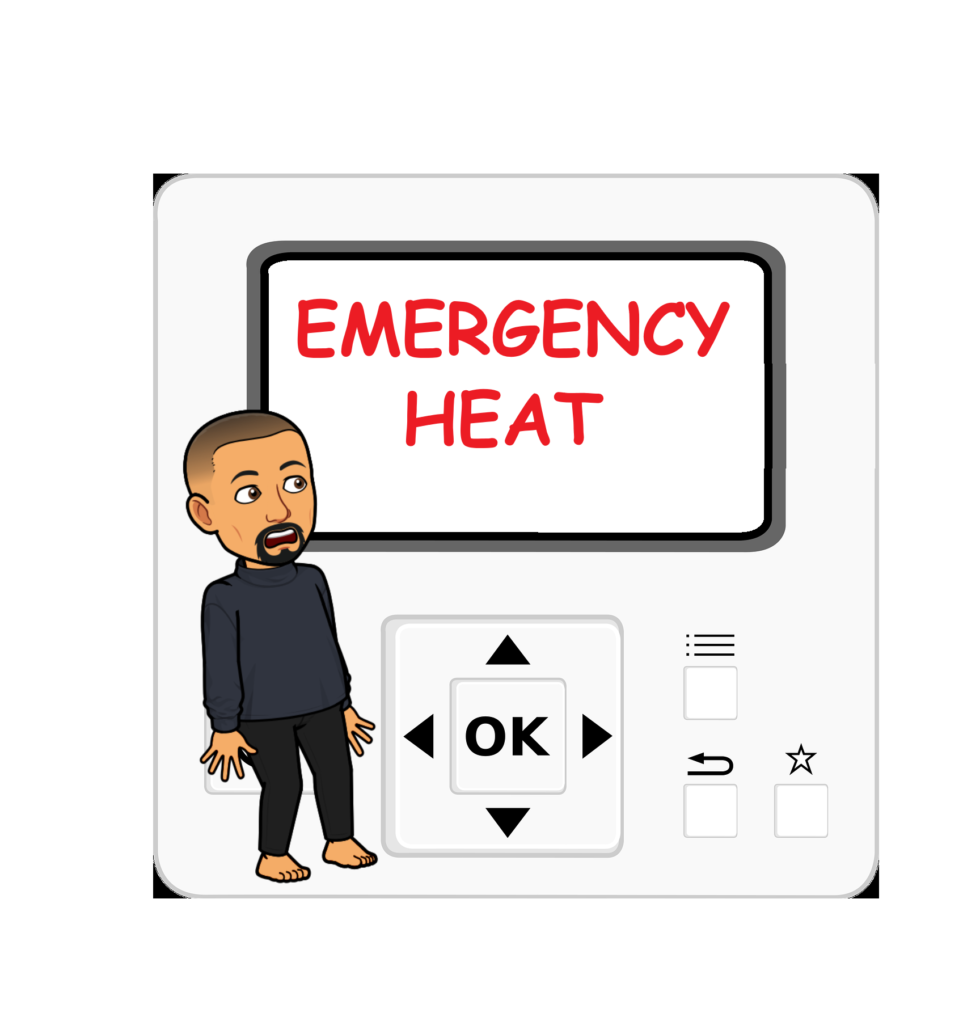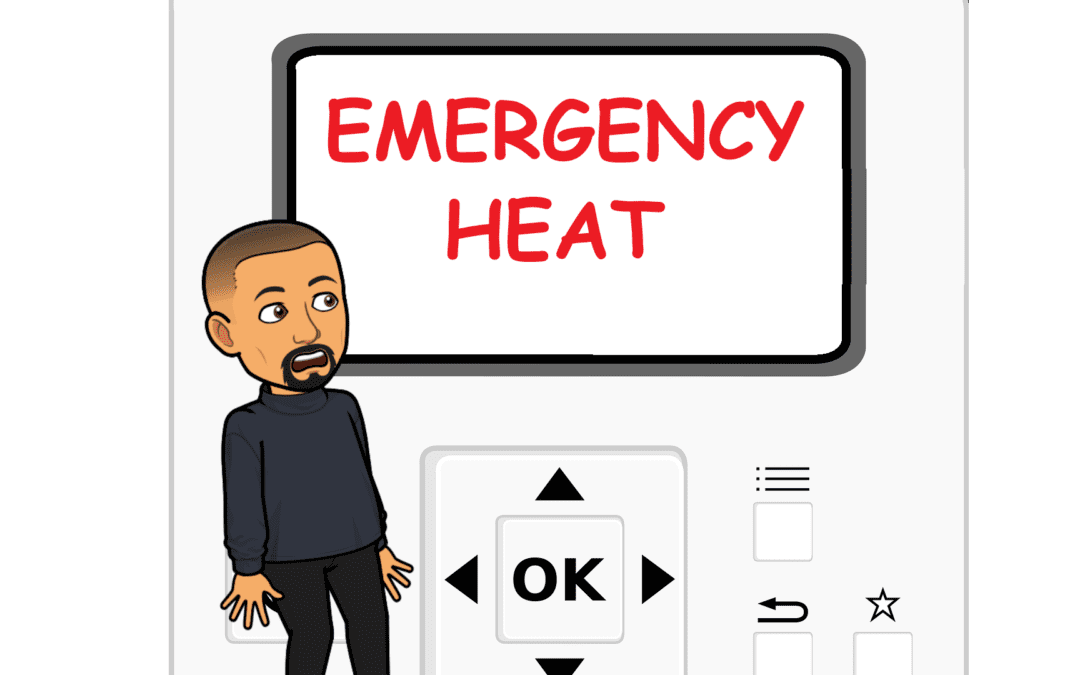What to do when your thermostat shows "emergency heat"
My Thermostat Shows “Emergency Heat. What Does This Mean?”
Have you come home on a freezing cold day only to walk by your thermostat and see the words “Aux Heat” flashing on the read-out? It may also say “Emergency Heat” or “Aux Heat.” If you have a central heat pump instead of a regular central air conditioning system, in the winter, you may see your heat pump emergency heat settings kicking into action happen quite often.
But anything that is flashing on the screen or a bright red light on your thermostat can’t mean something good, right? Well, it can be a good thing for your home and family in the right situation.
In this article, we’ll help answer these questions you’re probably asking yourself:
What does auxiliary heat on my thermostat mean?
Is it bad to use the auxiliary heating setting?
What is the difference between aux heat and emergency heat on a thermostat?
How can I stop my auxiliary heat from turning on?
What Does Aux Heat Mean?
Auxiliary heat on your thermostat is your backup heating system within your heat pump, otherwise known as electric resistance heating. Your thermostat inside your home is actually what determines when the emergency heat gets turned on.
For periods of time, the emergency heat indicator on your thermostat will light up or begin flashing, depending on if your home uses certain types of thermostats, letting you know when this happens.
This is because when the temperature inside your home drops below the goal temperature you’ve set the thermostat to, your thermostat energizes emergency heat. This commonly takes place once the indoor temperature on your thermostat reaches 2-3 degrees colder than the set indoor climate temperature. Emergency heat will turn off when your home reaches the thermostat set point.
There are two primary reasons that can cause your heat pump’s emergency heat setting to activate:
Your Heat Pump Can’t Produce Enough Heat to Reach The Temperature You Set On Your Thermostat
Sometimes your heating system just needs an extra boost of energy to help you reach the set temperature. That’s exactly what the emergency heat setting does for your home’s heat pump system.
Basically, if your heat pump is struggling to maintain its goal temperature, your emergency heat will turn on and give your heat pump a boost. Emergency heat will kick on when your heat pump cannot deliver enough warmth to heat your home to your desired temperature.
Typically, your heat pump will energize the emergency heat unit inside your secondary heating source to help reach its set temperature faster. If you see the indicator on, it means your heat pump’s electric resistance heating has been activated.
Your System is in “Defrost Mode”
Are you seeing ice form on your heat pump? If ice starts to build on your heat pump’s outdoor unit, your heat pump will undergo a “defrost cycle” to melt it by activating emergency heat.
During this time, the system will rely on emergency heat to keep your home warm. When winter temperatures reach freezing temperatures, the outdoor coils can have ice form on them. When that happens, your heat pump will automatically reverse the flow of the refrigerant so hot refrigerant is delivered to the outdoor unit to help melt the ice away.
Your heat pump will stop the standard heating process during this defrost cycle, causing some models to automatically switch to emergency heat until the defrost cycle is over.
Here Are The Signs That Your Heat Pump is in Defrost Mode
Steam and/or water is seen coming from the outdoor unit
The fan in the outdoor unit is not running
A blinking light on the unit itself to indicate it’s in defrost mode, in certain models
During freezing weather, the outdoor heat pump will be too cold to heat your home, which is when the emergency heating system will activate. Emergency heat turns on automatically to help heat your home more quickly if the temperature drops below freezing suddenly outside.
Emergency heat is best used when there’s also something wrong with your “first stage” heat. Let’s say your home is not reaching the set warm temperature and it’s because something has happened to your outdoor unit. You would then turn on the emergency heat and call for service. Again, this can happen if you’re experiencing freezing temperatures outside. This is NOT a big deal unless the emergency heat is constantly on for days at a time – that’s when you should call for a heater tune up or service on your heating system.
How to Stop Emergency Heat From Coming On
It may seem like it isn’t much you can do when your Honeywell thermostat says the emergency heat is on or any other model thermostat. If the temperatures are extremely frigid outside, even this may be too much for your unit. You may need to make some additional changes to your home to keep the emergency heat from coming on.
Lower The Set Heat Temperature
More often than not, the emergency heat is coming on because the temperature in the home is set too high. You are asking your HVAC system to work too hard to maintain a stable temperature. Setting the thermostat for somewhere between 62-68 degrees is all you should need to do to get the situation under control.
Make Your Home More Comfortable
Another effective way you can keep the emergency heat from running is to create a cozy, warmer atmosphere inside your home. Open your window shades in the day in the winter and let the sun warm rooms whenever possible. Remember you can always layer up wearing thick clothes and snuggling up with a cozy blanket.
Close Off The Vents In Unused Rooms
Most people have areas of their homes, like a spare bedroom or a den, that are not used throughout the day. Close off those rooms by shutting the door and closing the vents so that the rest of the warm air can be redirected to the rest of your home.
Schedule a No Problema Heating Tune-Up
It’s always best to schedule a time to have your heating system inspected and tuned up to prevent breakdowns.
Look At Your Thermostat
If you had your heating maintenance tune up performed back in the fall or earlier and emergency heating is still staying on, your thermostat could be the culprit. Newer thermostats may cause the emergency heat to come on more quickly than older ones. If the temperature does not pick up within the first few minutes, many of the new models will prompt the emergency heat setting.
In summary, when your thermostat says “emergency heat” or “Aux Heat” it’s not really an emergency. It’s your heating system compensating for really harsh weather conditions outside. If your heat pump system ever fails to work, just give us a call at Air & Plumbing Today 210-519-5959 and we’ll be ready to respond!

Our Offices
3615 Tavern Oaks San Antonio TX 78247
Call Us
Email Us
Hours
24/7 EMERGENCY SERVICE


